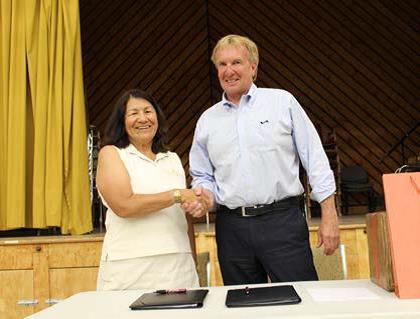Our operations overlap with the traditional territory of more First Nations in British Columbia than any other licensee in the province. We engage with First Nations across our operations, which extend from Cranbrook in the south, Houston to the west, Fort Nelson to the north, and Alberta to the east.
We are committed to the development of mutually beneficial opportunities for First Nations participation in our planning and operations, including economic development, procurement, and education and employment.
Examples of successful business arrangements with First Nations, include those with Ktunaxa , Lheidli T’enneh, Moricetown, Cheslatta, McLeod Lake, Bonaparte, Blueberry River, Doig River, Halfway River, Prophet River, Saulteau, Wet’suwet’en and West Moberly First Nations, to name a few.
We are also committed to supporting meaningful collaboration and transparent engagement of First Nations in our operations and in the forest sector. For example, i n 2014 we signed agreements with the Ktunaxa Nation Council (KNC) that define our working relationship and are based on mutual respect and understanding. The Ktunaxa traditional territory is home to our operations in the East Kootenay region. We agreed to work cooperatively with the KNC to ensure our operations do not unjustifiably infringe on their aboriginal rights and title.

Kathryn Teneese, chair of the Ktunaxa Nation Council, and Canfor President and CEO Don Kayne signed agreements in 2014.
Through open communication with First Nations, we ensure that areas of cultural importance are managed in a way that retains their traditions and values, and benefits from local and traditional knowledge.
We identify and track culturally important, sacred and spiritual sites so they can be managed appropriately or protected, make sure our staff are trained in cultural awareness, and consider traditional knowledge and uses in our forestry planning. We commissioned archeological assessments at many of our operations in 2014 to identify areas that should be protected. In all cases, these assessments and proposed management strategies are referred to the relevant First Nations.
In 2014, the Supreme Court of Canada granted aboriginal title and rights to the Tsilhqot’in Nation for lands in British Columbia’s central interior. We have no operations in this area, and the decision does not impact areas outside of the Tsilhqot’in Nation territory. The decision did create some short-term uncertainty for government decision-makers charged with granting authorizations but also served to help clarify and reinforce the rights and obligations of First Nations, government and resource industry participants. Over the long term, we believe that this will result in greater certainty and stability for all parties.